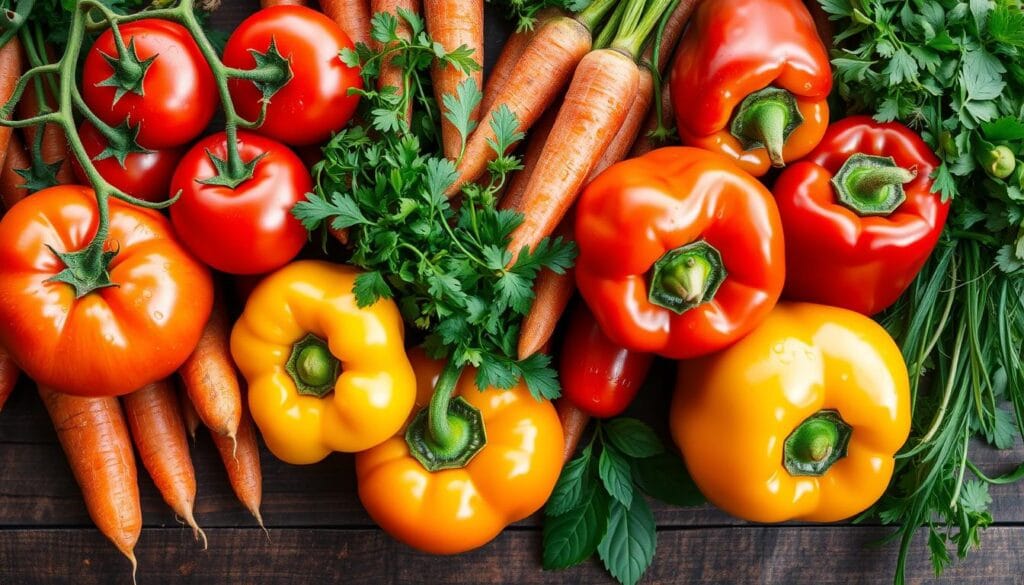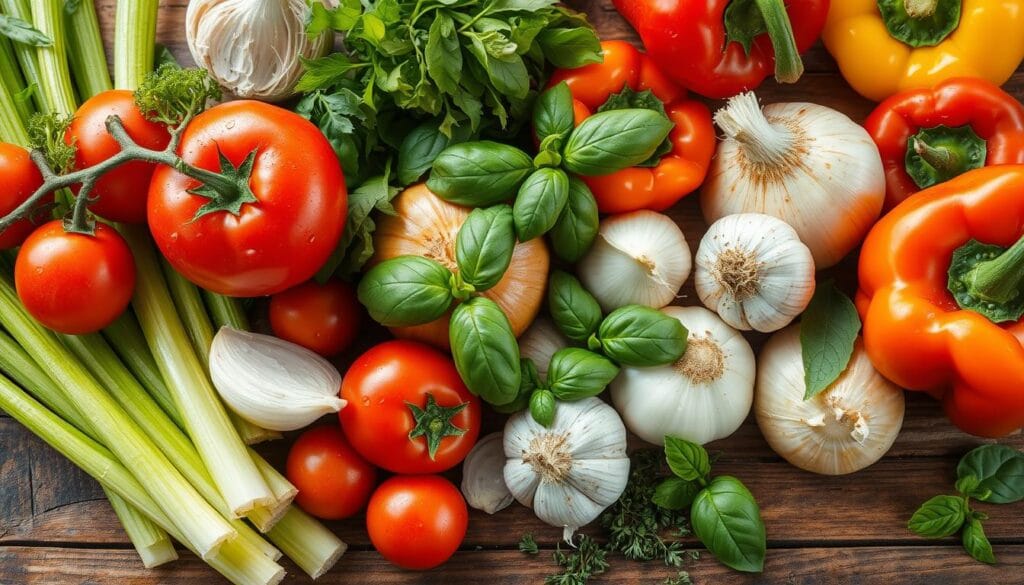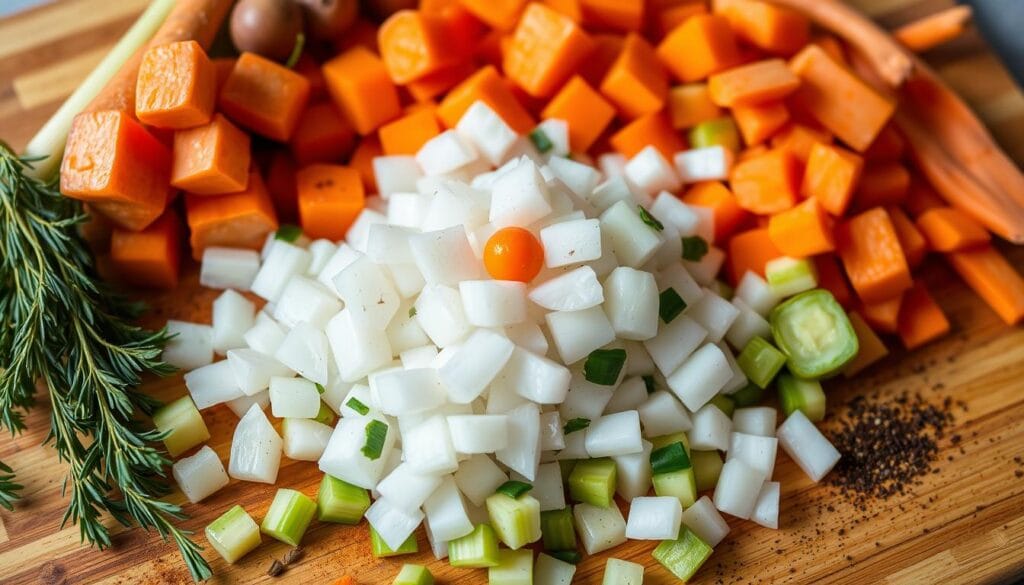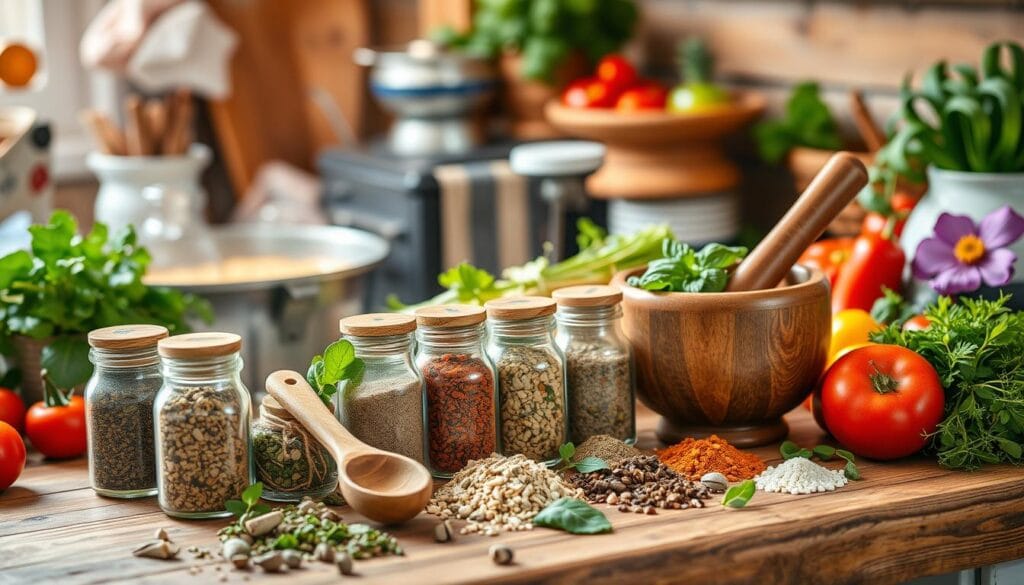Winter brings a chill, but a warm bowl of homemade soup is perfect. It can remind us of our grandmother’s kitchen or cozy Sunday dinners. What makes homemade soup special? It’s the small techniques and care that turn simple ingredients into a flavorful dish. Let’s discover What makes homemade soup taste better ?
Main Highlights :
- Develop deeper flavors by allowing the soup to sit and letting proteins break down
- Use fresh, seasonal produce for the best flavor
- Infuse broth with Parmesan rind for a rich, creamy texture
- Finish with a splash of acid like lemon juice or vinegar to brighten the soup
- Layering flavors at each step of the cooking process is key to a well-rounded taste
The Foundation of Flavorful Homemade Soup
Making a tasty homemade soup begins with knowing the basics. It’s about understanding flavor profiles, using quality ingredients, and fresh produce. These steps help create a soup that’s truly satisfying.
Understanding Basic Flavor Profiles
Soup’s flavor comes from balancing five tastes: sweet, salty, sour, bitter, and umami. Think about each taste to mix them well. Try different mixes to find your favorite.
Role of Quality Ingredients
The ingredients you choose greatly affect your soup’s taste. Pick the best quality ingredients and let them stand out. A good homemade broth is key, making your soup richer than water.
Importance of Fresh Produce
Use lots of fresh produce in your soups. Fresh veggies, herbs, and spices add great flavor. Try new things with seasonal produce for exciting tastes.

Learning about flavor, quality, and fresh produce will help you make amazing soups. Your senses and soul will thank you. Now let’s find out what makes homemade soup taste better.
What Makes Homemade Soup Taste Better
To make the homemade soup taste better, pick the right ingredients and use special techniques. Start by adding more aromatics, like onions, than usual. This creates a strong flavor base. Also, choose one or two main ingredients to avoid too many tastes.
Balance the flavors with sweet, salty, sour, bitter, and umami. Adding butter makes the soup richer. Making a big batch lets the flavors mix well over time. Try making it a day early to improve the soup taste.
- Use more aromatics, especially onions, than typical recipes
- Focus on one or two main ingredients to prevent overpowering flavors
- Balance sweet, salty, sour, bitter, and umami elements
- Add butter for a rich, velvety texture
- Make large batches and let the soup sit overnight for enhanced flavor
| Ingredient | Impact on Soup Flavor |
|---|---|
| Onions | Provide a foundation of savory, aromatic flavors |
| Butter | Adds a creamy richness and velvety mouthfeel |
| Fresh herbs | Infuse the soup with bright, herbaceous notes |
| Acidic elements (lemon juice, vinegar) | Balance the richness and enhance the overall flavor |

By using these soup flavor enhancement and homemade soup techniques, you can make soups that everyone will enjoy.
Building a Strong Aromatic Base
Making a tasty homemade soup begins with a strong aromatic base. The key is the mirepoix, a mix of onions, carrots, and celery. Sautéing these veggies in the right mix unlocks a flavor world that’s the soup’s backbone.
Traditional Mirepoix Techniques
The mirepoix mix is 2 parts onions, 1 part carrots, and 1 part celery. This mix is the base for many French soups, stews, and sauces. Using more onions adds a deeper umami flavor to your dish.
Sweating vs. Browning Vegetables
How you cook your mirepoix changes the flavor. Sweating them low and slow makes a light, sweet base. Browning them high adds a rich, complex taste.
Timing Your Aromatics
When to add your aromatics matters. For long-simmering soups, add them at the start. For quick soups, add them later to keep flavors bright.

Learning to make a flavorful base is key to great soups. Try different mixes, cooking ways, and timing. Find what works best for you and your soup.
The Art of Proper Seasoning
Learning to season your soups right is key to making them taste amazing. By mixing sweet, salty, sour, bitter, and umami flavors, you can make your soup taste better. This makes every bite a joy.
Start by knowing how acidity helps your soup. A bit of lemon juice or vinegar can make the flavors pop. It adds depth and makes your soup more interesting. Add these a little at a time, tasting as you go.
Then, think about how salt improves your soup’s taste. Salt brings out the best in your ingredients. It makes sweet, bitter, and umami flavors shine. Use salt while cooking and adjust it as needed.
- Try different spices and herbs for your soup. For example, chili might need cumin and chili powder. Chicken noodle soup might get a nice touch from thyme and parsley.
- Add these flavors slowly, at different cooking stages. This builds a rich flavor that grows with each step.
- Always taste and adjust the seasoning. Make sure the balance of flavors is perfect before serving.
With the right seasoning, your homemade soups will be a hit. They’ll impress your guests and make them want more.

Mastering Stock and Broth Making
Homemade stock is key to flavorful soups and stews. It’s much better than store-bought. Making your stock or broth adds depth to any dish. Whether it’s a light chicken broth or a hearty beef bone broth, it can change your cooking.
Homemade vs. Store-bought Stock
Store-bought stocks and broths are easy but lack flavor. Homemade stocks simmer for hours, releasing all the goodness from bones and veggies. This makes a richer, more satisfying soup base that store-bought can’t match.
Essential Stock Ingredients
- Bones (for non-vegetarian stocks): Chicken, beef, or a mix, adding collagen and minerals
- Aromatic vegetables: Onions, carrots, celery, garlic
- Fresh herbs: Thyme, parsley, bay leaves
- Spices: Peppercorns, cloves, star anise
Simmering Techniques
For a tasty stock, you need patience and slow simmering. Start with cold water and slowly heat it up. This lets the flavors meld over hours. Skim off any scum and avoid boiling too hard. A slow simmer makes a rich, gelatinous stock that makes soups better.
| Homemade Stock | Store-bought Stock |
|---|---|
| Simmered low and slow for maximum flavor extraction | Quickly produced for convenience |
| Richer, more gelatinous texture | Thinner, less concentrated flavor |
| Customizable with personal ingredients | Standardized recipe and ingredients |
| Cost-effective when using kitchen scraps | Higher price point |
Spending time on homemade stock or bone broth makes your soup base and stock ingredients better. It turns your soups into something special.
Enhancing Texture and Consistency
Homemade soups can be truly satisfying. The right texture and consistency make all the difference. Here are some tips to improve your soup texture and make creamy soups you’ll love.
Use high-powered blenders like Vitamix for silky-smooth soups. They blend ingredients to a fine, uniform consistency. But, adding different textures like crunchy toppings can make your soups even better.
Change your soup’s consistency by adjusting the liquid-to-solid ratio. For a thicker soup, use less liquid or add thickeners like pureed veggies. For a lighter soup, add more broth.
An immersion blender is great for large batches of soup. Just blend right in the pot until it’s perfect. This way, you get a mix of smooth and chunky that’s just right.
Mastering blending and adjusting consistency opens up new possibilities. Try different blending techniques to find the perfect balance. Your taste buds will thank you.
The Science Behind Next-Day Soup Flavor
Ever wonder why your homemade soup tastes better the next day? It’s because of the science behind soup flavors. As soups rest, they undergo chemical changes that make them taste deeper and more complex.
Chemical Changes During Storage
Letting your soup sit in the fridge overnight lets flavors mix and blend. Slow cooking breaks down proteins and starches. Cooling lets ingredients keep interacting. This makes the soup’s smell and taste better. Canned ingredients like tomatoes, beans, and meat also get better, losing any bad taste.
Optimal Storage Methods
- Keep your soup in airtight containers in the fridge for up to 4 days.
- Freeze soup in small containers for up to 3 months for longer storage.
- Don’t leave soup out for more than 2 hours, as bacteria can grow.
Reheating Best Practices
When reheating, be careful. Warm the soup gently, but don’t boil it. Boiling can dull the flavors and ruin the texture. This keeps the soup’s taste rich and the ingredients fresh.
The science behind next-day soup flavor shows how cooking is complex. With the right storage and reheating, your soups and stews will taste even better the second time.
Advanced Flavor Layering Techniques
Making homemade soup better than basic is more than just simmering ingredients. Chefs use advanced flavor layering techniques to make soups with complex flavors. This method takes more work but makes your soup stand out.
Begin by cooking onions, carrots, and celery to make a tasty base. Then, cook meats until they’re browned for extra flavor. Use wine, broth, or vinegar to get all the browned bits – they’re flavor gold.
Add ingredients like fish sauce or Parmesan rinds for more depth. Roasting veggies before adding them adds caramelized flavor. Use herbs like parsley or thyme at different times for a layered herbal profile.
Finish with a bit of acid, like lemon juice or vinegar, to brighten and balance the flavors. Try adding truffle oil or aged balsamic for a memorable flavor experience.
With a bit more effort and chef-inspired techniques, you can turn a simple soup into a flavor-packed masterpiece. Dive into the art of flavor layering and discover the true potential of homemade soup.
Natural Thickening Methods
Looking for ways to make your homemade soup thicker? Try using starchy vegetables, beans, and other natural agents. They can turn a watery soup into a rich, comforting meal.
Using Vegetables as Thickeners
Starchy veggies like potatoes, winter squash, and corn are great for thickening soups. Just puree some cooked veggies and mix them back into the soup. This adds a creamy texture.
Bean and Legume Options
Legumes like chickpeas, beans, and lentils are full of starch. When you crush or puree them, they thicken your soup. They also add protein and nutrition.
Alternative Thickening Agents
For gluten-free or low-carb soups, use arrowroot powder or cornstarch. Mix a little with broth or water, then whisk it into the soup. Simmering will make it smooth and glossy.
Experimenting with natural thickeners is key to the perfect soup texture. With a little creativity, you can make a thin soup into a thick, nourishing dish.
Conclusion
Start by using top-notch ingredients to make your homemade soup better. Learn to build layers of flavor. Focus on the basics like a strong aromatic base and homemade stock.
Try different ingredients like chickpeas and eggplant. Add fats like olive oil or bacon for richness. The secret to great soup is in the details, like sautéing onions and adjusting seasonings.
With practice, you can make amazing soups at home. Be creative and try new things. Follow these homemade soup tips and soup-making techniques to make soups as good as restaurant ones. Wish you enjoyed this article about what makes homemade soup taste better.
FAQ
What makes homemade soup taste better?
Homemade soup can taste better in many ways. Using homemade broth adds richness. Adding fresh herbs at the end brings extra flavor. Layering ingredients builds depth.
Adding a Parmesan rind adds richness. A splash of lemon juice or vinegar can brighten it. Toppings add texture and flavor.
How can I create depth of flavor in my homemade soup?
To add depth, balance sweet, salty, sour, bitter, and umami. Choose quality ingredients, focusing on a few main ones. Fresh produce adds the best flavor.
Homemade broth is key for flavor. Use onions, garlic, and herbs to start strong.
How can I enhance the flavor of my homemade soup?
To boost flavor, add more aromatics like onions. Focus on a few main ingredients to avoid muddled tastes. Balance flavors well, considering all five elements.
Butter adds richness. Making large batches can improve flavor. Soup tastes better a day after making.
What is the key to building a strong flavor base for homemade soup?
Start with a mirepoix (onions, celery, carrots). Use more onions for depth. Add garlic, black peppercorn, thyme, and bay leaves.
Adjust these based on your soup type. Properly cooking vegetables enhances flavor.
How do I balance flavors in my homemade soup?
Balance flavors by mixing sweet, salty, sour, bitter, and umami. Add acidity to cut richness. Layer flavors during cooking.
Use salt to enhance taste. Choose spices and herbs that fit your soup. Adjust seasoning before serving.
Why is homemade stock important for flavorful soup?
Homemade stock tastes better than store-bought. Make it with bones, veggies, herbs, and spices. Simmer slowly to get flavors and collagen.
Freeze it for later. If buying, choose high-quality ones with bones, onions, carrots, celery, garlic, and herbs.
How can I achieve the perfect texture and consistency for my homemade soup?
For smooth soups, use a Vitamix. Add different textures for interest. Adjust consistency with natural thickeners or less liquid.
Use an immersion blender for big batches. Mix smooth and chunky for a good mouthfeel.
Why does soup often taste better the next day?
Soup tastes better next day due to flavor enhancement. Store it in airtight containers in the fridge for up to 4 days.
Freeze for up to 3 months. Reheat gently to keep flavors and textures. Some soups, like cream-based, may not freeze well.
What are some advanced techniques for building flavor in homemade soup?
Build flavor by sautéing aromatics, browning meats, and deglazing. Use umami-rich ingredients like fish sauce or Parmesan rinds.
Incorporate roasted veggies for depth. Add fresh herbs at different stages for layered flavors. Finish with acid and fresh herbs to brighten it. Try unique ingredients like truffle oil or aged balsamic.
How can I naturally thicken my homemade soup?
Use starchy veggies like potatoes or winter squash to thicken. Puree some soup for body. Beans or lentils add thickness and protein.
Rice or barley are natural thickeners. For gluten-free, use arrowroot or cornstarch. Reduce liquid for a thicker soup.

